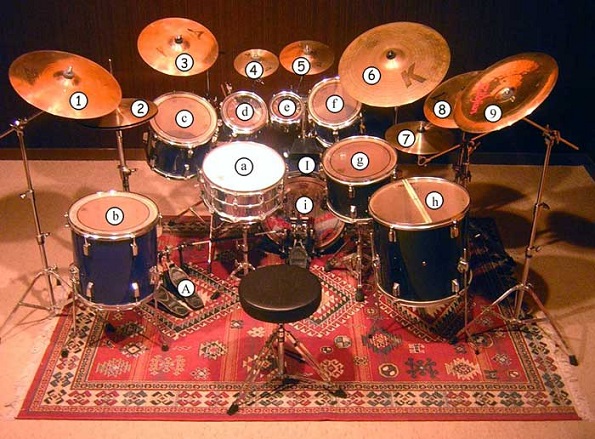
 : : : Lessons : : Conceiving your drum set : Set 8 : Fusion, metal
: : : Lessons : : Conceiving your drum set : Set 8 : Fusion, metal
Set 8 : Fusion, metal
(9 drums, 11 cymbals, 1 cowbell, 1 double pedal)

- Description:
-
- 1 : Crash 17''
- 2: Hi-hat 14''
- 3 : Crash 15''
- 4 : Splash 8''
- 5 : Splash 10''
- 6 : Ride 20''
- 7: Suspended hi-hat 12''
- 8 : Crash 16''
- 9: Chinese 17''
-
- a: Snare drum 14 x 5''
- b: Piccolo bass tom 14''
- c: Piccolo baritone tom 12''
- d: Alto tom 8''
- e: Soprano tom 6''
- f: Tenor tom 10''
- g: Baritone tom 13''
- h: Bass tom 16''
- i: Bass Drum 20''
- I: Large cowbell
- A: Double pedal or double bass drum
Here the symmetry is almost total because we find the cross descent system also for the drums. Some drummers like Bill Bruford (Yes, Rick Wakeman, King Crimson, Genesis, without toms above the bass drum and with a cable hi-hat with pedal on the left and cymbals above the snare drum) or Mike Mangini (Steve Vai, Dream Theater, with a cymbals setup close to the set 9) have even almost touching drums on the left, under the hi-hat cymbals (which on the contrary, takes them away (you can not have all the advantages!)). Others make only a partial use of this system as Dave Weckl (Chick Corea) in the 1990s (having only his three floor toms on this model) and Billy Cobham (John McLaughlin) or Dom Famularo in the 2000s (arranging them in pairs, the low tom to the left, the high to the right and each pair going down from left to right).
This set favors complex and unexpected combinations on the melodic aspect, with Arpeggio playing (without doubled notes).
However, the symmetrical set up and the large number of drums here, allow more conventional descents (in continuous single stroke roll with passages) to the right or to the left, starting from the smallest tom placed in the center, or ascents in contrary, starting from the extreme left or the extreme right and stopping at the center, or to alternate up and down scales (or “steppings” with several notes on each drum) from left to right or right to left on all toms.
I must say after trying, it gives a stereophonic effect quite enjoyable (if I can use this expression).
Note that the snare drum finds again here its central "hub" place , more than ever. This central position allows continuous passages from the snare to any type of instrument, which is also of the most beautiful effect.
Finally, by playing one note per drum, it gives an effect of "diffraction" between the order of tones and the place of the drums, which is equally impressive for the listener (because rare for a musical instrument but it is quite easy to achieve on the gestural aspect).
I'm just warning of the attraction toward the pure original sound effect to the detriment of the freedom of gestural expression, virtuosity and creativity, which are the only great reservations I have about this type of set. But it remains for me one of the most interesting of the moment and besides I appreciate it a lot with a playing with five congas, for its effectiveness, because it takes more large gestures with hand percussions, if you want to make passages between different instruments (see the description of this set at the lesson "The playing with 4 or 5 congas").
Marc De Douvan, march 2006, augmentation and translation in English: march 2015.
© 2005 Marc de Douvan Crédits Mentions légales
